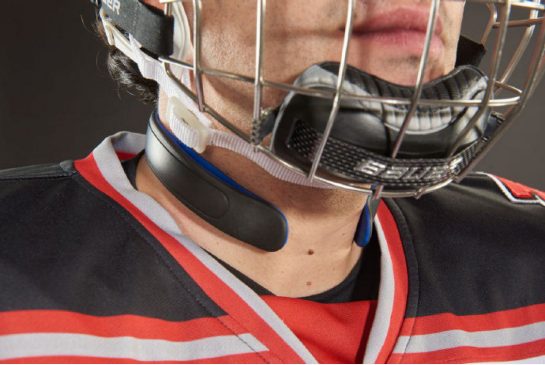Bauer’s parent company unveils new neck collar said to decrease concussions

By @MichaelCaples –
Performance Sports Group, the parent company of Bauer Hockey, announced yesterday a new device that’s supposed to reduce concussions in athletic competition.
It’s not a new helmet, however, but a neck collar.
The new product, a “proprietary yet easy-to-use band worn on the neck,” is designed to effect blood volume in the vein structure of a player’s brain. The collar, which gives slight pressure to the neck, is intended to increase blood volume levels, which would minimize ‘sloshing’ of the brain inside the skull.
“Slosh Theory” – identified by Dr. Julian Bailes, Chairman of the Department of Neurosurgery and Co-director of the NorthShore University HealthSystem Neurological institute; Dr. Joseph Fisher, Senior Scientist, Toronto General Research Institute; and Dr. David Smith, Visiting Scientist, Cincinnati Children’s Hospital and Medical Center – is one of the key causes of mild traumatic brain injury. When a person’s head experiences impact or sudden movement, the brain sloshes inside the skull and can also rotate or strike the inside walls of the cranium, tearing brain fibers. These impacts contribute to mTBI (abbreviation of the aforementioned head trauma).
An increased blood volume inside the brain, as provided by this collar, would limit the sloshing.
“This is the first solution to address mTBI from inside the skull,” said Bailes, a founding member of the Brain Injury Research Institute who is portrayed in the upcoming Sony Pictures film Concussion for his work to identify Chronic Traumatic Encephalopathy (CTE) in former professional football players, in a release. “By increasing the volume of blood in the cranial cavity, there’s less room for the brain to move which reduces the overall slosh effect which we believe reduces mTBI. The research results are very encouraging and we are excited to work with Performance Sports Group to continue the important research and bring this technology to market.”
Performance Sports Group acquired the worldwide license for the collar from Q30 Sports, LLC in Oct. 2015. They are in the process of obtaining the necessary regulatory approvals from the U.S. Food & Drug Administration, Health Canada and other regulatory bodies.
According to two separate peer-reviewed research studies, researches found an 83-percent reduction in the number of torn fibers in a standard concussion model when the collar was used.
PSG held a presentation on Tuesday in New York with Bailes; Dr. Gregory Myer, Director of Research for the Division of Sports Medicine at Cincinnati Children’s hospital; Dr. Neilank Jha, Neurosurgeon and Spine Surgeon and Chairman of KONKUSSION; and Dr. Charles Tator, Senior Scientist, Toronto Western Hospital.
Kevin Davis, CEO of Performance Sports Group, and Hockey Hall of Fame inductee Mark Messier also took part in the discussion.
“It was exciting to bring together such a renowned group of medical experts in the field of mild traumatic brain injury and have them agree that this technology – and the supporting science behind it – could be a step forward in addressing mTBI in sports,” Davis said in a release. “As a leading manufacturer of protective sports equipment, we believe it is our obligation to do everything we can to help bring this exciting new technology to athletes around the world.”
The collar is not available to the public yet, however.
“There is more research that needs to be conducted and we are working with the relevant regulatory bodies to ensure we are following the appropriate and requisite steps to bring this technology to market,” Davis said. “Subject to completion of all the required testing, we would hope to potentially begin offering this product to athletes within the next 12-24 months.”
You can watch video from the presentation here.
The full press release about the new technology can be seen here, as well.

